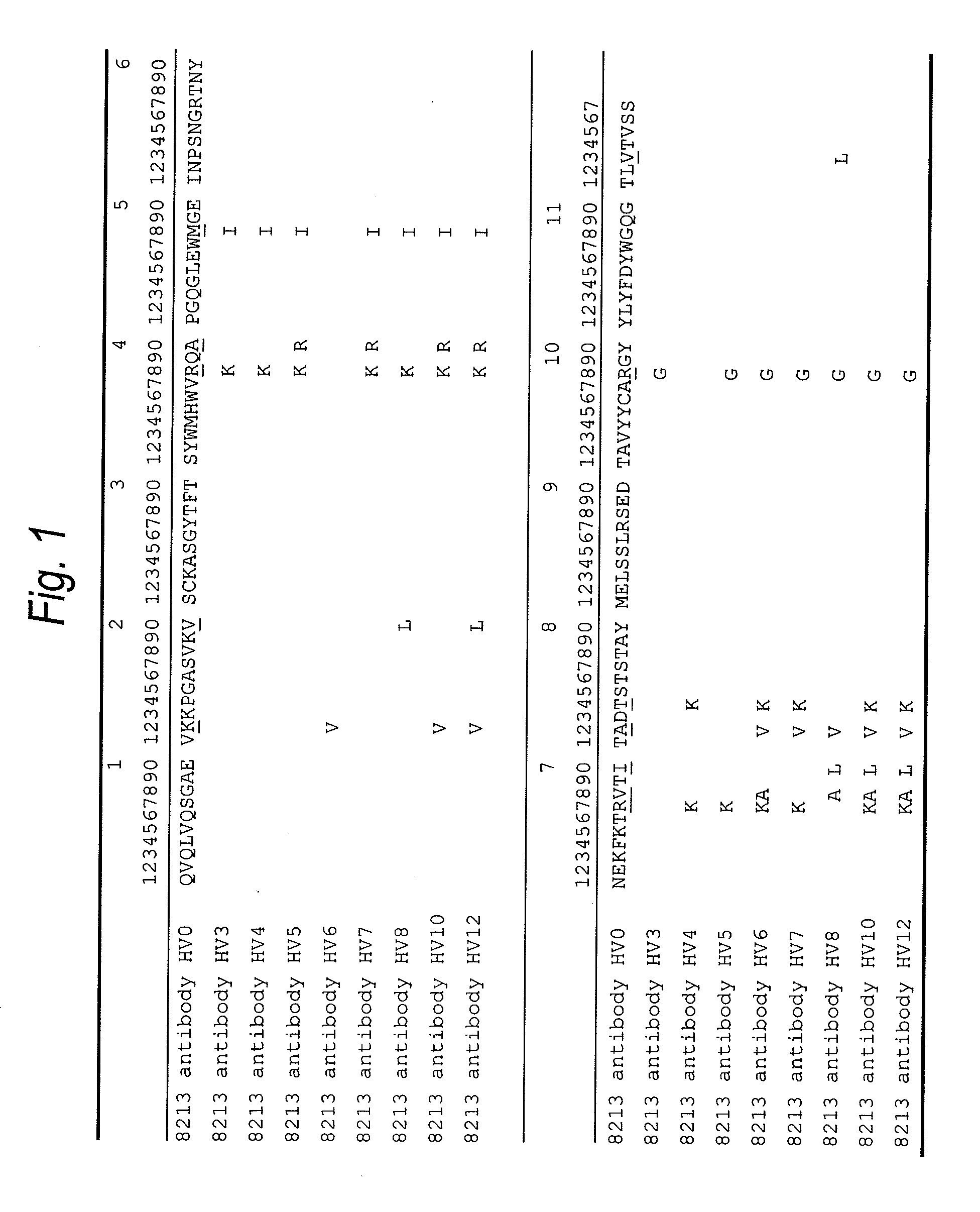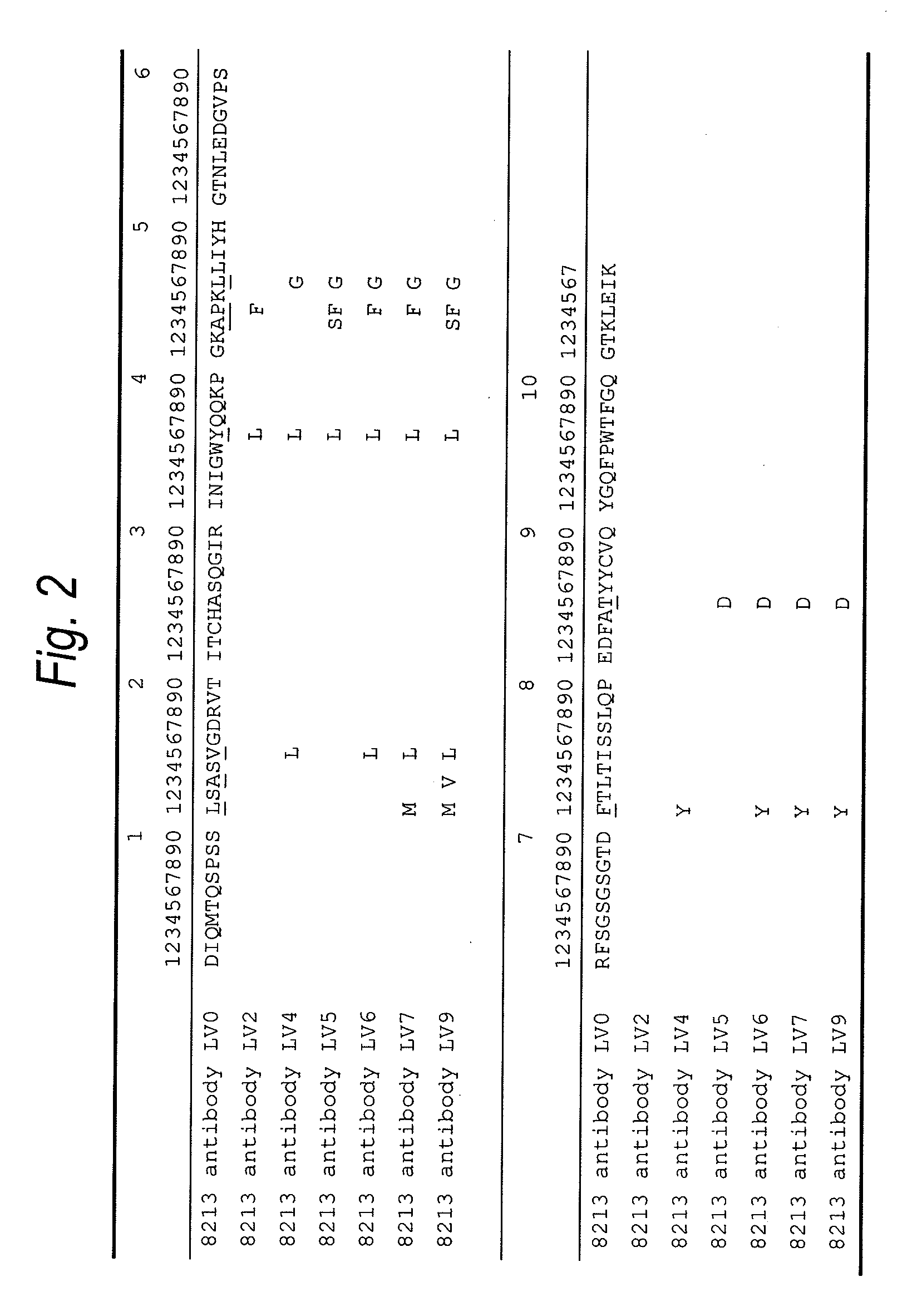Anti-tim-3 antibody
a technology of anti-tim-3 antibody and monoclonal antibody, which is applied in the introduction of antibody medical ingredients, peptide/protein ingredients, and vector-based foreign material introduction, etc., can solve the problem of no report of adcc activity of monoclonal antibody against human tim-3, and achieve the effect of higher adcc activity and higher adcc activity
- Summary
- Abstract
- Description
- Claims
- Application Information
AI Technical Summary
Benefits of technology
Problems solved by technology
Method used
Image
Examples
example
Example 1
Molecular Cloning of Human TIM-3 cDNA and Establishment of Stable Expression Cell
[0568]Human TIM-3 cDNA was amplified by PCR using ExTaq (manufactured by Takara Bio Inc.) and Human MTC panel (manufactured by Clontech) as a template. For primers, TIM-3 Fw2 (SEQ ID NO: 31) and TIM-3 Re2 (SEQ ID NO: 32) were used. The obtained PCR product was inserted into pGEM-T Easy vector (manufactured by Promega Corp.), and the plasmid was introduced into TOP10 One shot competent cells (manufactured by Invitrogen) to amplify. The plasmid DNA was extracted by the miniprep method.
[0569]By analyzing the sequence of purified DNA using primers TIM-3 Fw and TIM-3 Re2, the clone having the same sequence as the coding region of GenBank accession number NM—032782 was selected. A human TIM-3 retrovirus (hTIM-3 / pMCs-IG) was constructed by recombination of the insert of the selected clone into pMCs-IRES-GFP vector (manufactured by Cell Biolabs Inc.) using Retrovirus Constructive System Ampho (manufact...
example 2
Preparation of Expression Vector of Fusion Protein of Soluble Extracellular Human TIM-3-Human Fc
[0571]The cDNA encoding the extracellular region of human TIM-3 was amplified by PCR using ExTaq (manufactured by Takara Bio Inc.) and hTIM-3 / pMCs-Ig constructed in Example 1 as a template. For primers, pMCs-Fw (SEQ ID NO: 33) and TIM3ED-FcReXba 2 (SEQ ID NO: 34) were used.
[0572]The amplified PCR product was inserted into pTracer-CMV-FLAG-human Fc vetctor [modified vector in which FLAG and Fc domain of human IgG1 were inserted into pTracer-CMV (manufactured by Invitrogen) vector between XbaI site and ApaI site]. After the plasmid was introduced into TOP10 One shot competent cells (manufactured by Invitrogen) to amplify, the plasmid DNA (sTIM-3-FLAG-Fc / pTracerCMV) was extracted by miniprep method.
[0573]By the analysis of the DNA sequence using T7 (SEQ ID NO: 35) and hTIM-3 Fw1 (SEQ ID NO: 36) as a primer, the purified sTIM-3-FLAG-Fc / pTracerCMV was confirmed to have the same nucleotide sequ...
example 3
Preparation of Expression Vector of Soluble Extracellular Human TIM-3
[0574]The cDNA encoding the extracellular region of human TIM-3 was amplified by PCR using ExTaq (manufactured by Takara Bio Inc.) and sTIM-3-FLAG-Fc / pTracerCMV established in Example 2 as a template. As primers, TIM-3 Fw2 (SEQ ID NO: 31) and TIM3ED-FLAG4aa (SEQ ID NO: 39) were used.
[0575]Next, FLAG epitope was ligated by PCR method using ExTaq (manufactured by Takara Bio Inc.), TIM-3 Fw2 (SEQ ID NO: 31) and C-FLAG-NotR2 (SEQ ID NO: 40) as primers and the obtained PCR product as a template. The PCR product was inserted into pGEM-T Easy vector (manufactured by Promega Corp.). After the plasmid was introduced into TOP10 One shot competent cells (manufactured by Invitrogen) to amplify the plasmid DNA (sTIM-3-FLAG / pEF6Myc_HisC) was extracted by the miniprep method.
[0576]By the DNA sequence analysis using T7 (SEQ ID NO: 35) and BGH-R (SEQ ID NO: 41) as a primer, the purified sTIM-3-FLAG-Fc / pEF6 Myc_HisC was confirmed to...
PUM
| Property | Measurement | Unit |
|---|---|---|
| pH | aaaaa | aaaaa |
| pH | aaaaa | aaaaa |
| particle size | aaaaa | aaaaa |
Abstract
Description
Claims
Application Information
 Login to View More
Login to View More - R&D
- Intellectual Property
- Life Sciences
- Materials
- Tech Scout
- Unparalleled Data Quality
- Higher Quality Content
- 60% Fewer Hallucinations
Browse by: Latest US Patents, China's latest patents, Technical Efficacy Thesaurus, Application Domain, Technology Topic, Popular Technical Reports.
© 2025 PatSnap. All rights reserved.Legal|Privacy policy|Modern Slavery Act Transparency Statement|Sitemap|About US| Contact US: help@patsnap.com


